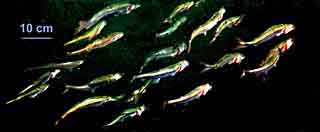Facts About Atlantic herring
Atlantic herring, a member of the Clupeidae family, is one of the most prevalent fish species worldwide, thriving in extensive schools on both sides of the Atlantic Ocean. These fish can grow up to 45 centimeters in length and weigh approximately 1.1 kilograms. They primarily consume copepods, krill, and small fish, and serve as prey for seals, whales, cod, and other larger fish.
The Atlantic herring fishery has historically been vital to the economies of regions such as New England and the Canadian Atlantic provinces, facilitated by the fish's tendency to gather near the coast. Atlantic herring possess a streamlined body with delicate gill structures and are particularly sensitive to environmental pollution. They spawn in estuaries, coastal waters, or offshore banks, with different populations spawning at various times depending on the region.
The Baltic herring, a subspecies located in the Baltic Sea, has distinctive traits and is a staple in local cuisines. Atlantic herring reach sexual maturity between 3 to 5 years of age and can live for 12 to 16 years. They play a crucial ecological role by converting zooplankton into fish, thus forming an essential part of the marine food web.
Herring are renowned for their schooling behavior, with massive schools that can cover vast ocean areas. These schools maintain precise spatial arrangements and exhibit coordinated behaviors to evade predators. Human interaction with Atlantic herring primarily involves fisheries management and their use as bait in recreational fishing. Despite their abundance, herring are difficult to maintain in aquariums due to their specific feeding and behavioral needs.

 Norway
Norway